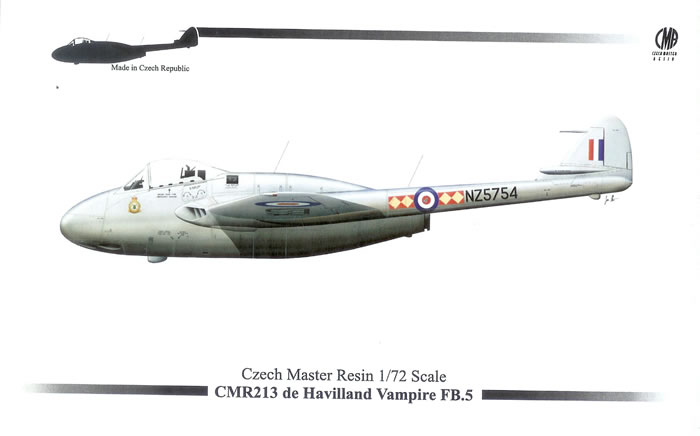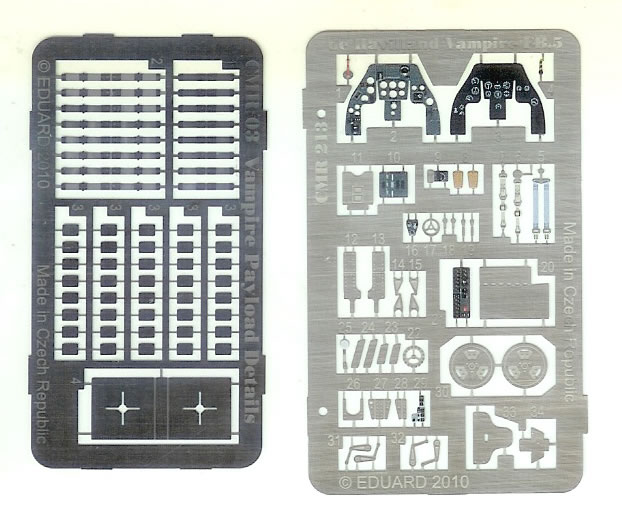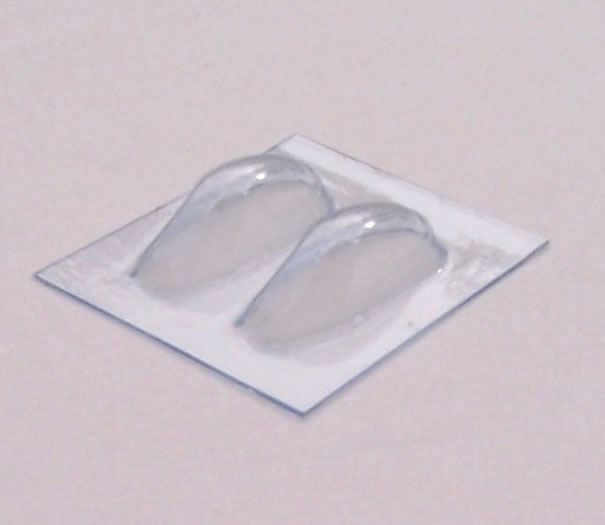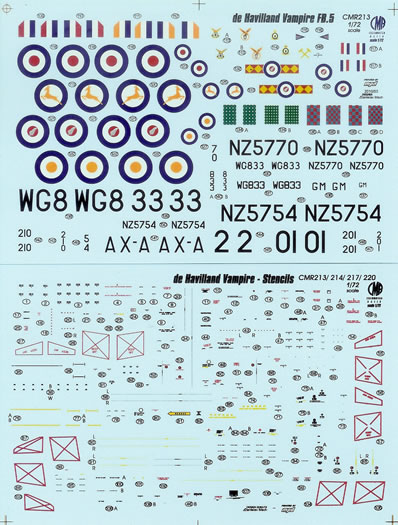|
de Havilland Vampire FB.5

Czech Master Resin, 1/72 scale
S u m m a r y : |
Catalogue Number: |
213 |
Scale: |
1/72 |
Contents & Media: |
109 x cream resin airframe & weapon parts, 7 x black resin undercarriage parts, 1 x Eduard coloured photo-etch (PE) fret of detail parts, 1 x plain PE fret of missile fins and mounting clips 2 x vac-from acetate canopies & 1 x Eduard pre-cut mask, decals for 6 aircraft |
Price: |
Available online from Hannants for £39.99, West Coast Hobbys for Cn$49.00, and various other CMR stockists. (Click here for currency conversion) |
Review Type: |
First Look |
Advantages: |
High quality, superbly detailed and very comprehensive kit. |
Disadvantages: |
None apparent. |
Conclusions: |
Suited to modellers with some resin and multi-media experience. A superb kit. |
Reviewed
by Mark Davies

HyperScale is proudly supported by Squadron.com
The Vampire was Britain’s second production jet fighter. The Vampire MK I had a very short endurance. The next production version, the F.3, improved on this by adopting more internal tankage and the ability to carry drop-tanks, although the drop tanks led to some changes in the tailplane. The opportunity was also taken to fit the more powerful Goblin 2 that increased static thrust by 200 lbs.
By 1948 the RAF had decided that the Gloster Meteor was the better of its two available jet fighters for continued development in the interceptor role until the next generation of jet fighters became available. However, the Vampire had a number of attractive features, and was well suited to specialise as a fighter-bomber.
Accordingly, de Havilland developed a strengthened wing with thicker skin, 1ft was clipped from each wingtip to enhance low-level handling, and extra strong points for up to 2,000 lbs. of underwing stores were added. The undercarriage was also strengthened to cope with the faster sink speeds on landing due to the higher wing loading. The F.3’s Goblin 2 engine was retained. In all more FB.5’s were to be produced than any other Vampire, 930 being built for the RAF and 88 for export.
CMR is working its way through all the major Vampire variants in 1/72 scale, and the FB.5 is the latest of the single seat versions. There have been two 1/72 major injected Vampire FB.5 kits in the past, an old one by Frog and the much better Heller offering (re-boxed by Airfix, Revell and others) which can be made to result in a nice model. Judging by its previous releases, CMR seems to be taking the position of offering the definitive version of any given Vampire mark. This latest kit follows the established format of previous single-seat Vampire releases and is described below.
The kit comes packaged in CMR’s now standard sturdy top opening box. The parts and decals are in heat sealed plastic bags, which in turn are sealed in a further bag with the instructions and photo-walkaround. The excellent straightforward instructions consist of double-sided A4 pages (see here). The parts map and constructional illustrations are very clear and easy to follow. More double-sided pages give comprehensive colours and markings plans. Colour notes and other written instructions are in English. Five more double-sided pages provide an excellent photo walkaround focused on various detail aspects of the aircraft.
The kit’s resin parts are in CMR’s usual cream resin, and very nicely moulded with no pinholes or other obvious flaws. A little flash is evident in a couple of places, but this can be removed easily and in seconds. The undercarriage is in a black resin that provides greater strength than the cream resin for fine weight-bearing parts.
The kit is awash with detail. Considerable attention to detail has been paid to the cockpit, wheel wells and flap bays. Detail levels are further enhanced by the pre-coloured Eduard PE set provided. With its dainty gun-sight and comprehensive interior this is a model many will want to have an open cockpit.

Two copies of the canopy provide for insurance or practice when cutting out. They come with An Eduard pre-cut mask which simply serves to make life easy when it comes to painting.

A lot of parts are associated with underwing loads appropriate to the fighter bomber-version and include:
- Two each of 250, 500 & 1,000lb. HEMC bombs,
- 60lb. S.A.P./H.E. Shell, No.1, Mk.1 Rocket Projectiles
- 25lb. A.P. Shot, No.1, Mk.1 Rocket Projectiles
- 60lb Concrete Practice Shell, Rocket Projectiles
- 25lb. Shot, Practice (Concrete) Rocket Projectiles
- Mk.8 Rocket Projector Rails
- Two 100 Imp. Gallon External Wing Tanks
The rockets have the option of ether resin or PE tail fins (the latter having a PE jig to keep the fins at 90 degrees from each other. Another PE option that will look great, but will also be quite challenging, are the mounting clips that sling the rockets from the rails each other. A nice aspect of the instructions is the inclusion of painting notes for the weapons giving warhead and stripe colours etc.
Decals are typical of CMR, being well registered and suggest good opacity. Based on past experience they should be very good to use; but like most Czech decals they will be quite thin and need to be floated into position, as they tend to adhere extremely well once there is no fluid under them.

Markings for one camouflaged and five overall high-speed silver schemes are provided, these being:
- WG833 'GM', Wing Leader, Nos. 603 & 612 Squadrons, Royal Auxiliary Air Force, early 1950's
- WG833 Wing Leader, Nos. 603 & 612 Squadrons, Royal Auxiliary Air Force, 1954
- NZ5754 No.75 Squadron, Royal New Zealand Air Force, Ohakea, October 1963
- NZ5770 "Yellow Hammers" Display Team, No.75 Squadron, Royal New Zealand Air Force, 1969
- 201 South African Air Force, February 1950
- 210 'AX-A', No.1 Squadron, South African Air Force, AFS Waterkloof, April 1950
This is a superbly executed kit with very high levels of detail and a good choice of underwing loads. Despite its tiny details and twin-boom layout it should go together in a straightforward manner.
Surely the definitive Vampire FB.5 kit.
Highly recommended.
Thanks to Czech Master Resin for this review sample.
CMR Models are available
online from Hannants in the UK,
Red Roo Models in Australia
and
quality specialist model retailers worldwide.
Text Copyright © 2010 by Mark Davies
This Page Created on 2 June, 2010
Last updated
2 June, 2010
Back to HyperScale
Main Page
Back to Reviews
Page
 |
